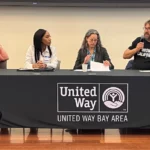Search
800,000 Pounds of Food Is Just the Beginning
June 30, 2020
Even in a typical year, West Valley Community Services distributes about 800,000 pounds of food to hungry people, all with the help of about 600 volunteers.
But this is no typical year.
“We noticed at the end of February that Coronavirus might be a bigger issue than what was being communicated by the federal government,” said Executive Director Josh Selo.
As public health officials grappled with the looming crisis, Selo and his team huddled to create a game plan. Nobody was calling it a pandemic yet, but they knew the coming wave would hit the Bay Area hard, and the region’s working poor and homeless people, the hardest.
They had to act fast, focus on food and rental assistance, and retool their operation to keep everyone safe. They knew that most volunteers, many over age 60, would have to stay home. They also knew that their walk-in and mobile food pantries would need to change dramatically. What they didn’t know was how immense the demand would be.
The organization, which serves residents of Cupertino, Saratoga, Los Gatos, Monte Sereno and West San Jose, has seen about a 350% year-over-year increase in the number of people coming in for help. Many are first-timers who, despite the soaring cost of housing, could still make ends meet before COVID-19.
One client in her 70s had spent her entire career in the hospitality industry, working as a server in a local restaurant. At the end of February, she noticed her tips were drying up because fewer customers were dining in. By March the boss called her into the office and she was let go.
Unable to pay rent in April, she turned to West Valley Community Services for help.
According to Selo, this type of scenario is common now that so many people are out of work. People who have been gainfully employed their entire lives are now faced with realities they’ve never had to face.
“These are not people that have had to rely on assistance from an organization like ours in the past,” Selo explained. “They don’t have a lot of savings and they’re not sure what to do.”
Ramping up quickly to meet soaring demand required not only foresight and experience but also additional funding from regional partners. Selo said that United Way Bay Area was among the first to step forward to provide funding in the wake of the pandemic.
“I can’t imagine how we would have been able to feel confident, especially in those first few days, in our ability to deliver these services without knowing that we had this incredible partner who had our backs and was stepping forward to make an investment in this work and in our clients’ needs,” he said.
So they’ve rolled up their sleeves, committing to the long haul and planning for the fall when kids go back to school. Their popular clothing and backpack program, which usually takes place in person at local Old Navy stores, will likely be modified so that kids can get supplies and still stay safe. The parents will need support too.
We look forward to working with WVCS and other organizations in the Emergency Assistance Network (EAN) in the coming months.
“We have a long and deep partnership with United Way Bay Area,” Selo said. “And it goes deeper than just the financial investment that they make in our organization and clients…we think of them as a true partner in the work that we’re doing to serve low-income and homeless individuals and families in the region.”
Please join us today and make a contribution to the United Way Bay Area COVID-19 Community Relief Fund to support individuals in this time of need.
DONATE NOW


